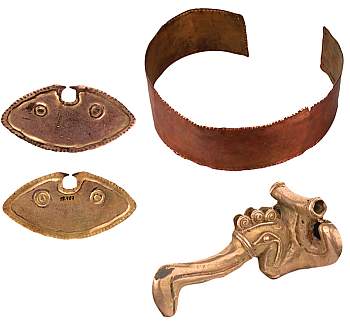The Nahuange tribe lived in the area of Colombia between 100 and 1000 A.D. and left behind many astonishing artifacts.

Image: Clark Manuel Rodríguez, Museo del Oro, Banco de la República
These artifacts are made of copper and have an ultrafine layer of gold on their surfaces. Modern scientists cannot explain how the Nahuange achieved this thin gold layer, which is only a few atoms thick. To account for this, researchers proposed a technique called "depletion gilding." According to this theory, the process involves mixing two metals (in this case, copper and gold) and then removing the copper from the surface using acids, leaving a layer of concentrated gold. However, this explanation lacks logic and has significant flaws.
"Depletion gilding" reported on achaeology.org
Why would one waste precious gold hidden inside an alloy where it is invisible? Furthermore, removing parts of the surface of an alloy does not cause the internal composition to change or concentrate in such a way as to create a pure layer of gold on the exterior. Despite these contradictions, "depletion gilding" remains the mainstream explanation. It seems to suffice for most, even if it does not withstand scrutiny.
The Nahuange artifacts, however, provide compelling evidence that metal transmutation techniques were available over 1,000 years ago and practiced using only the simplest tools.
Based on research published by human-resonance.org the actual process worked as follows:
- The artifacts were initially cast in plain copper.
- Silver tools were used to shape them in place and leave a thin layer of silver on the surface
- The pieces were then heated over a fire in a pot at 45°C - 50°C for one hour
- Then cooling to 40°C.
- This heating/cooling process was repeated multiple times.
- This precise heating and cooling, combined with gases from the fire, induced phonon resonance in the silver, transforming it into gold.
This process is now understood and has been successfully replicated in laboratories using standard equipment, thanks to the work of Dr. Joe Champion and his students.
Another fascinating aspect is that the symbols on the jewelry suggest the knowledge may have originated from extraterrestrial beings believed to have been in contact with the Nahuange people.